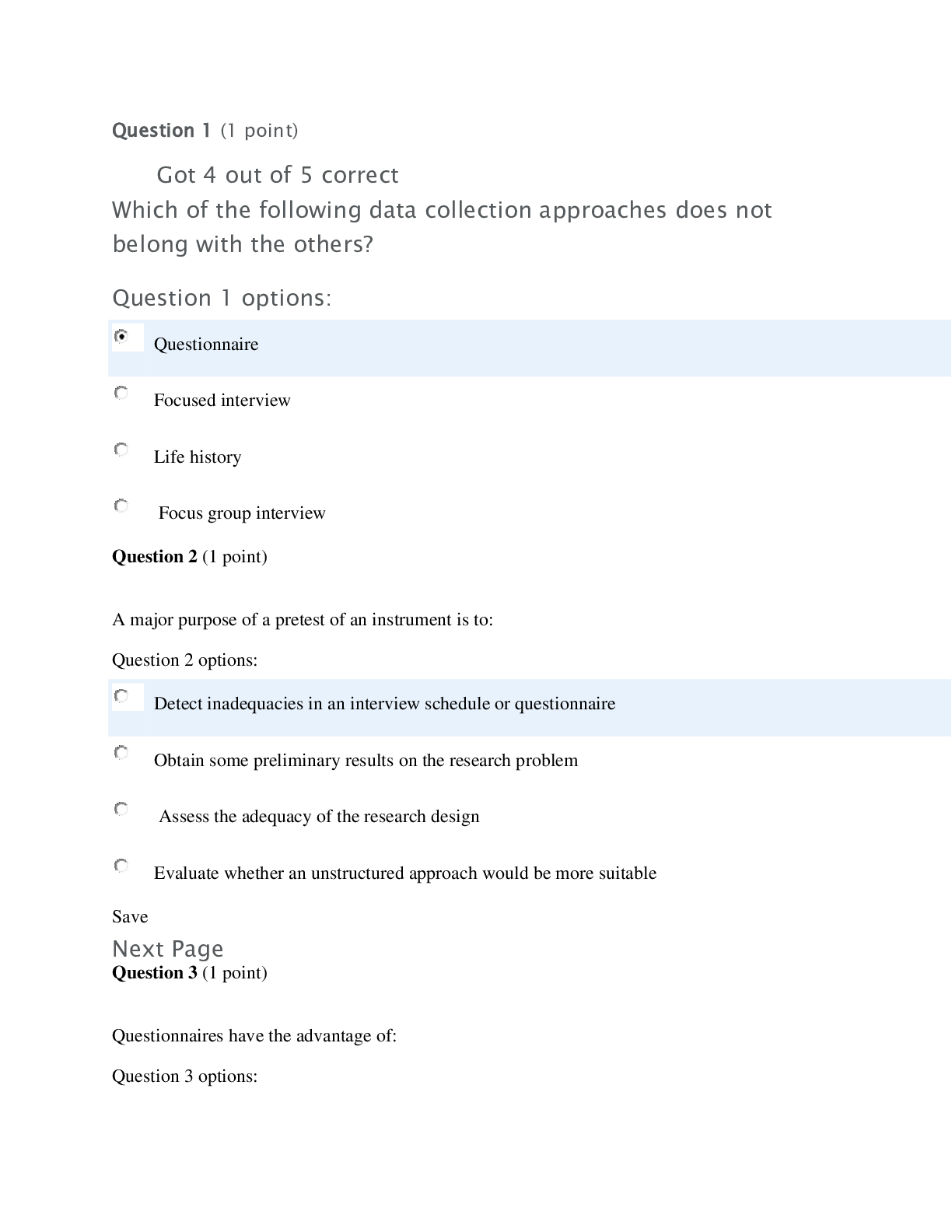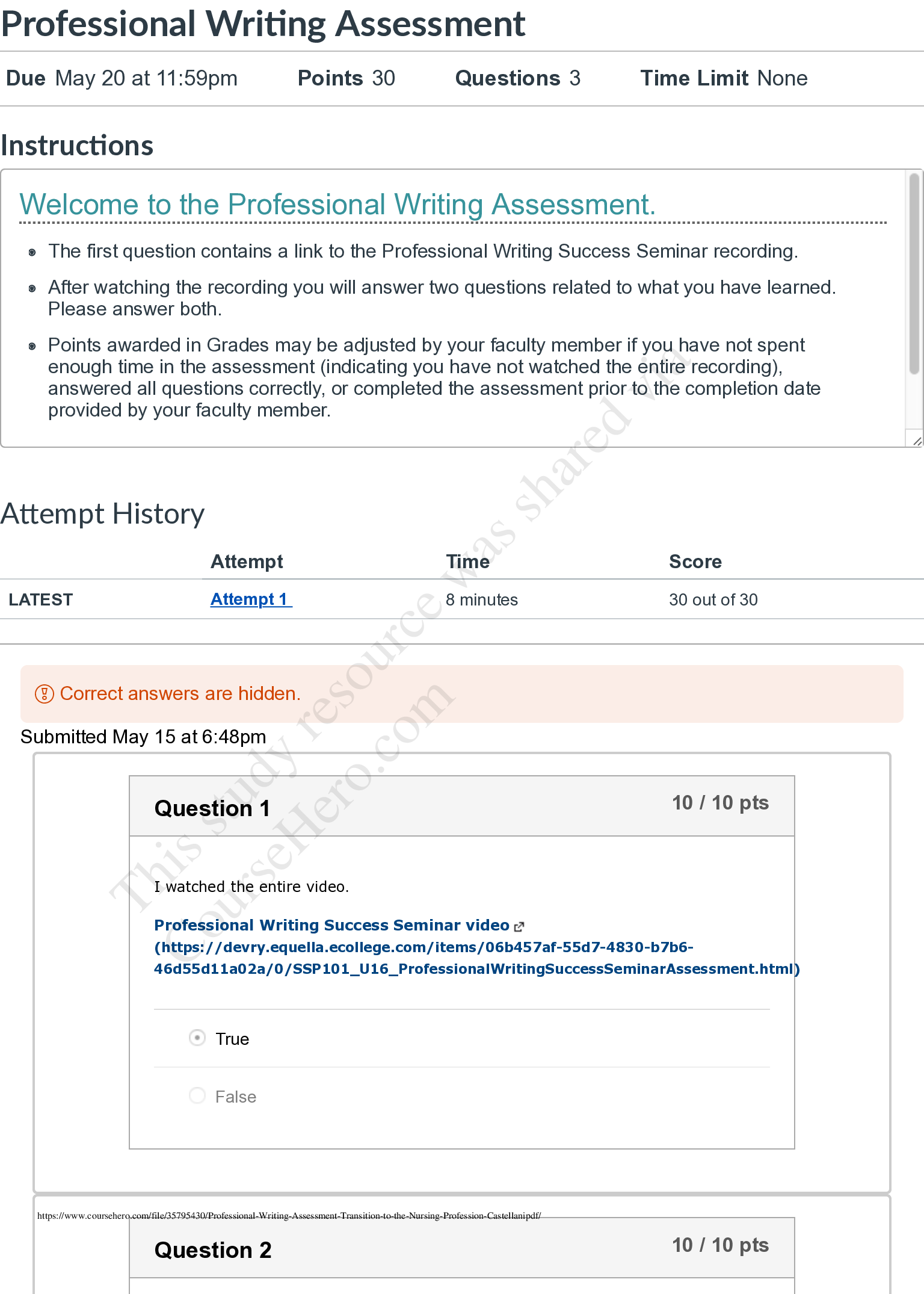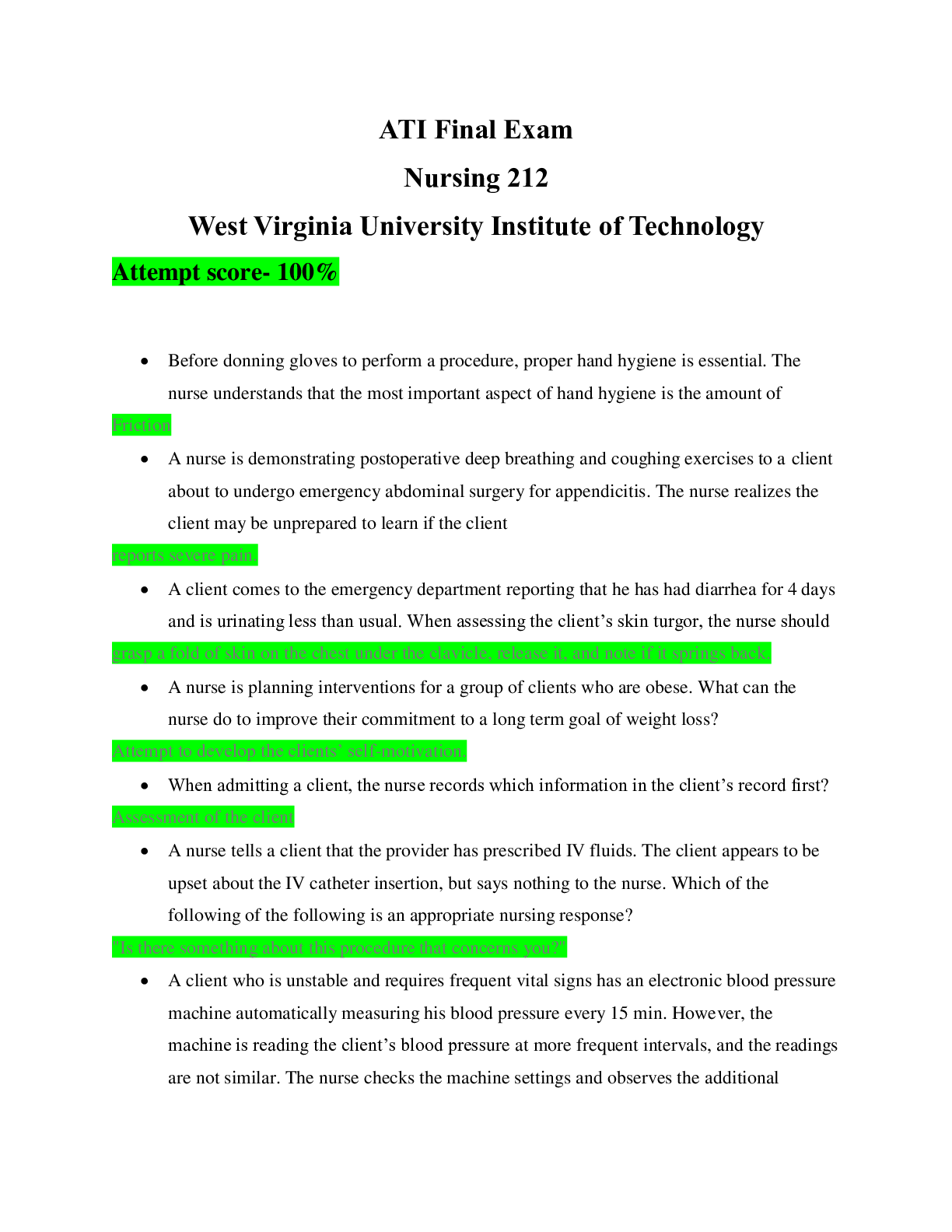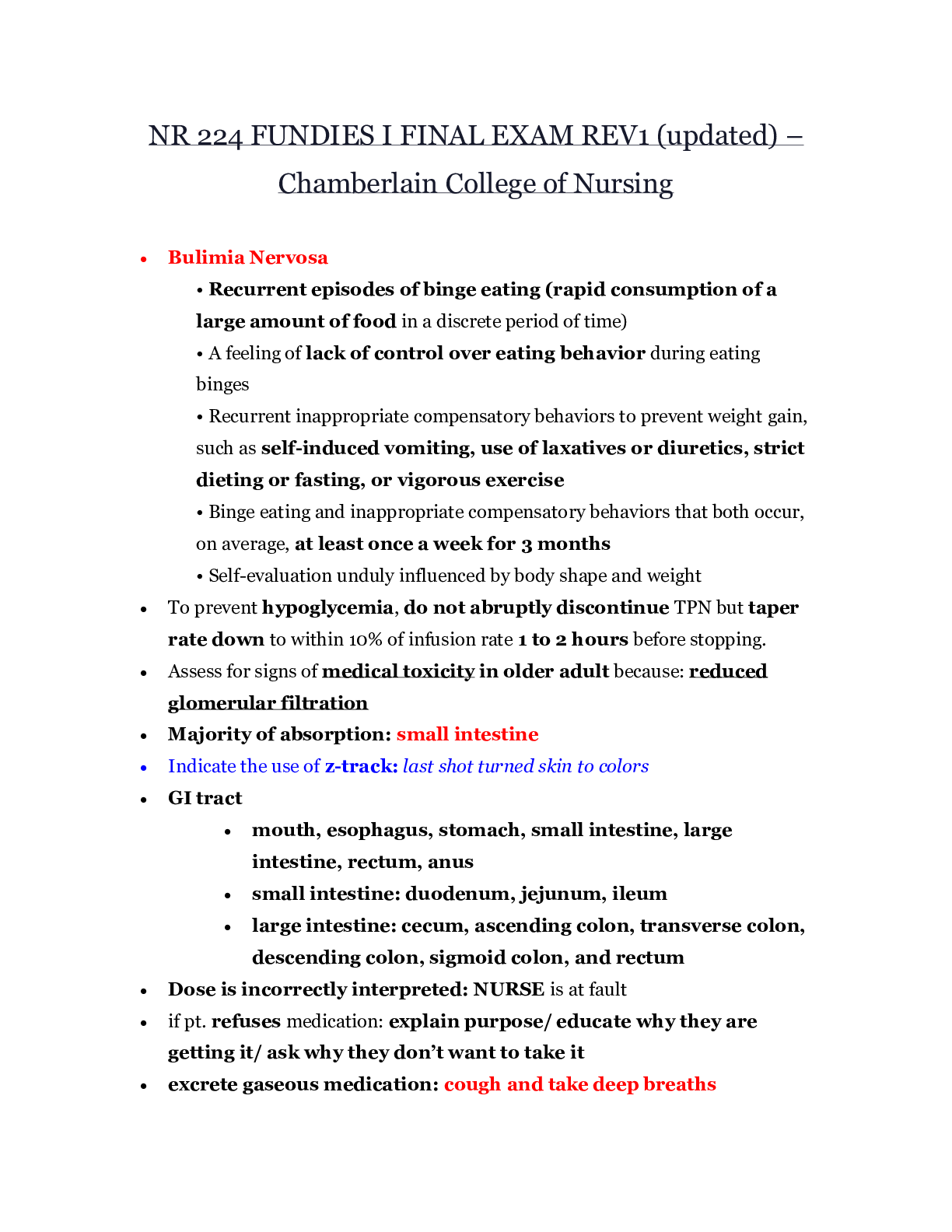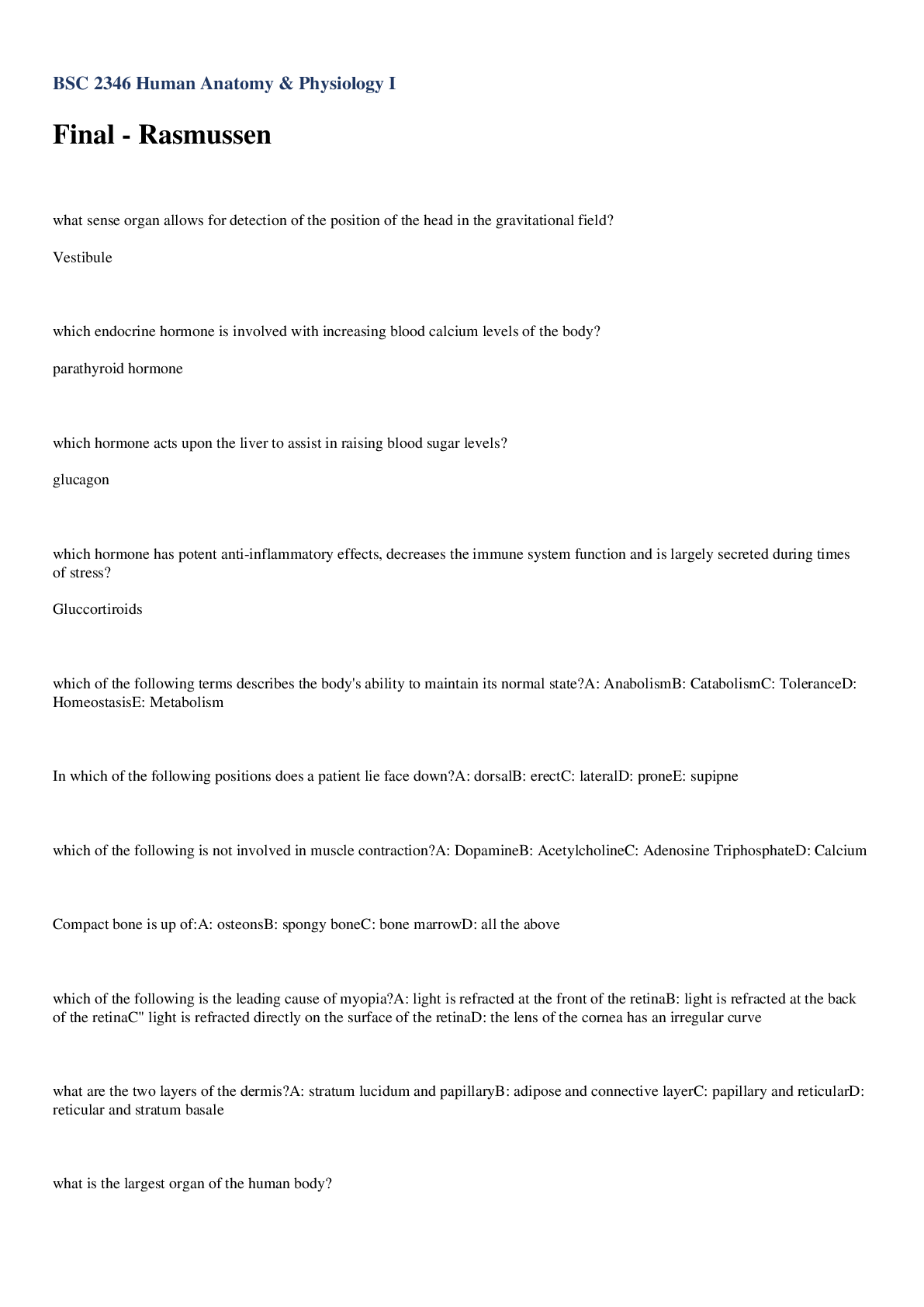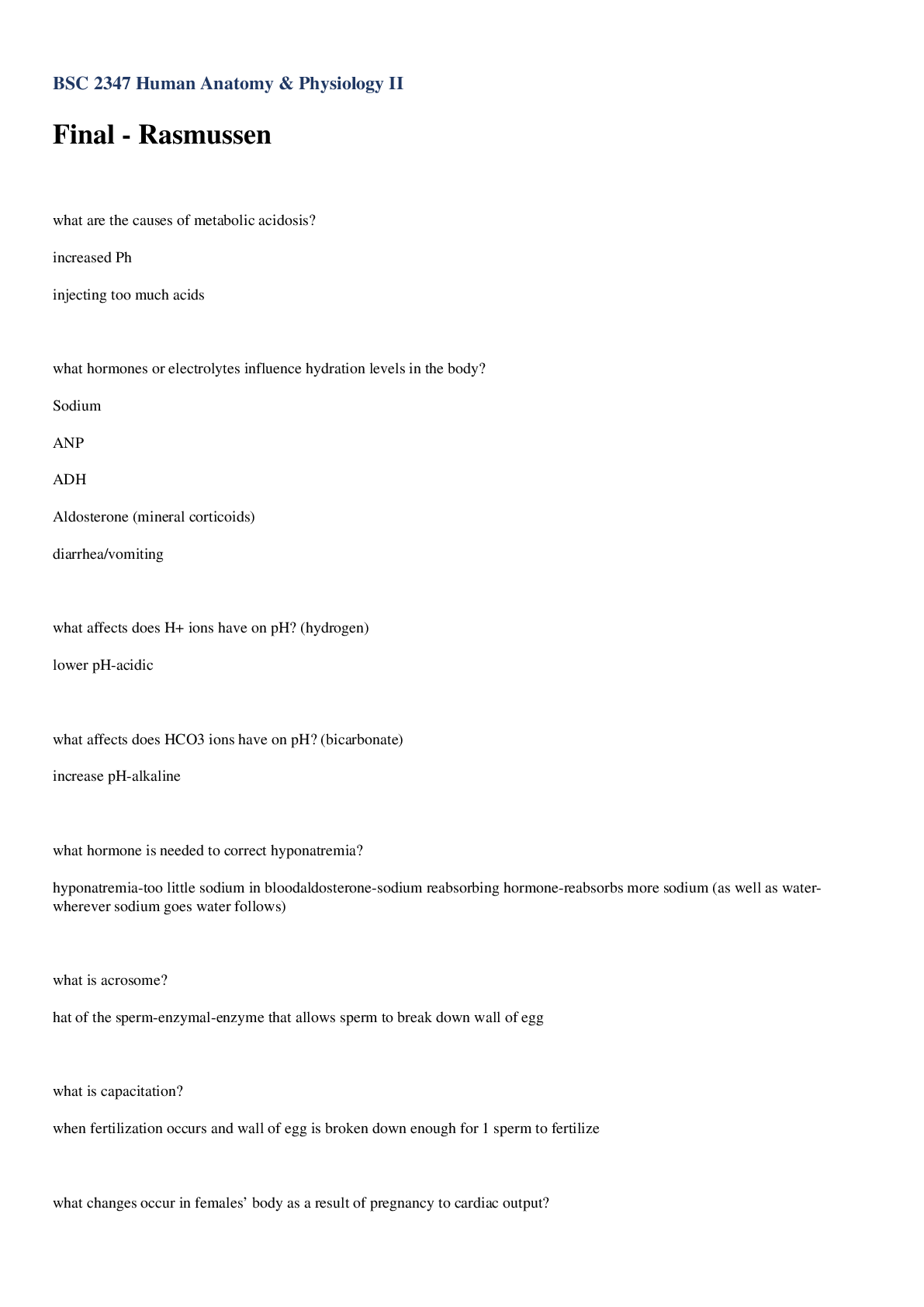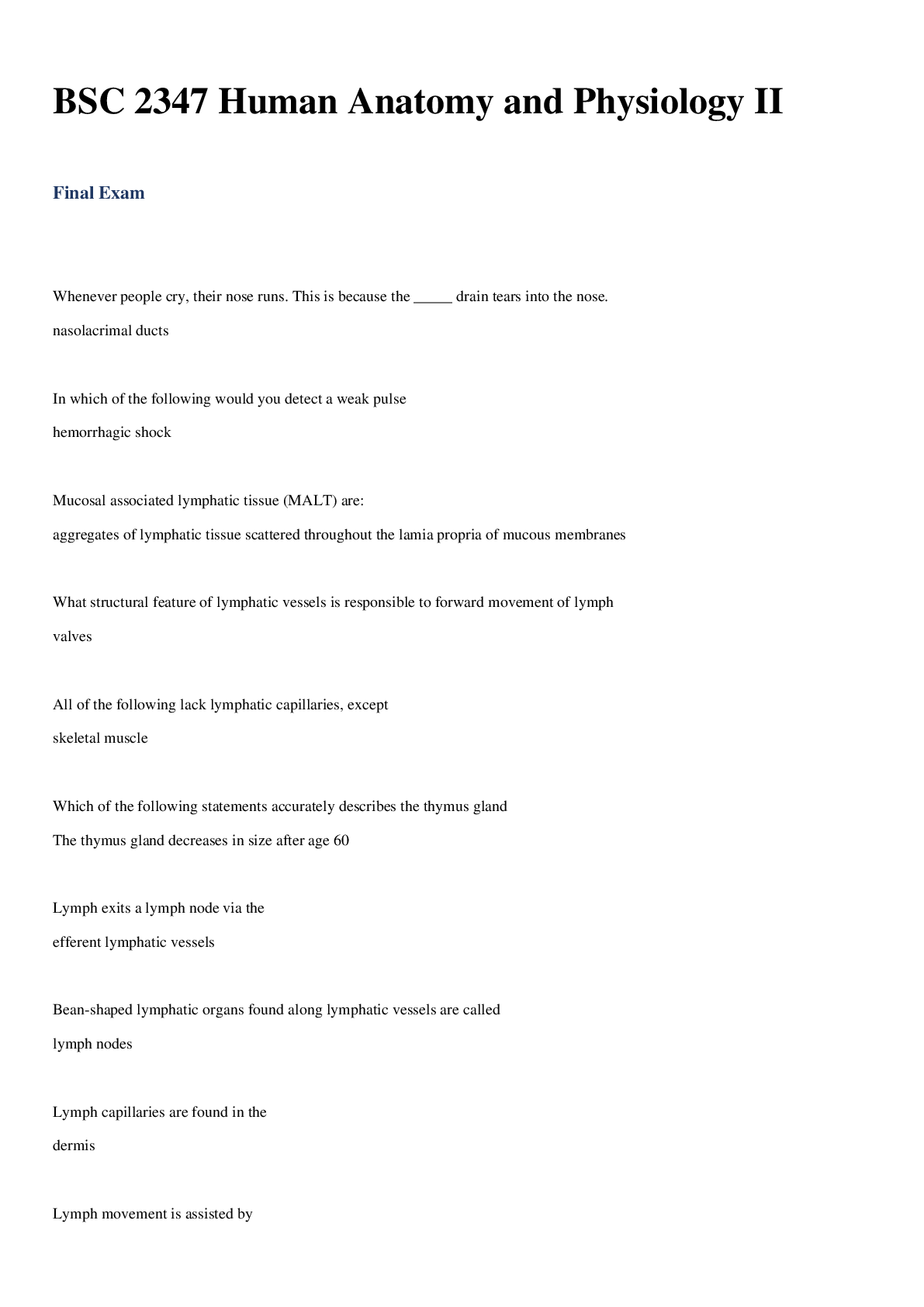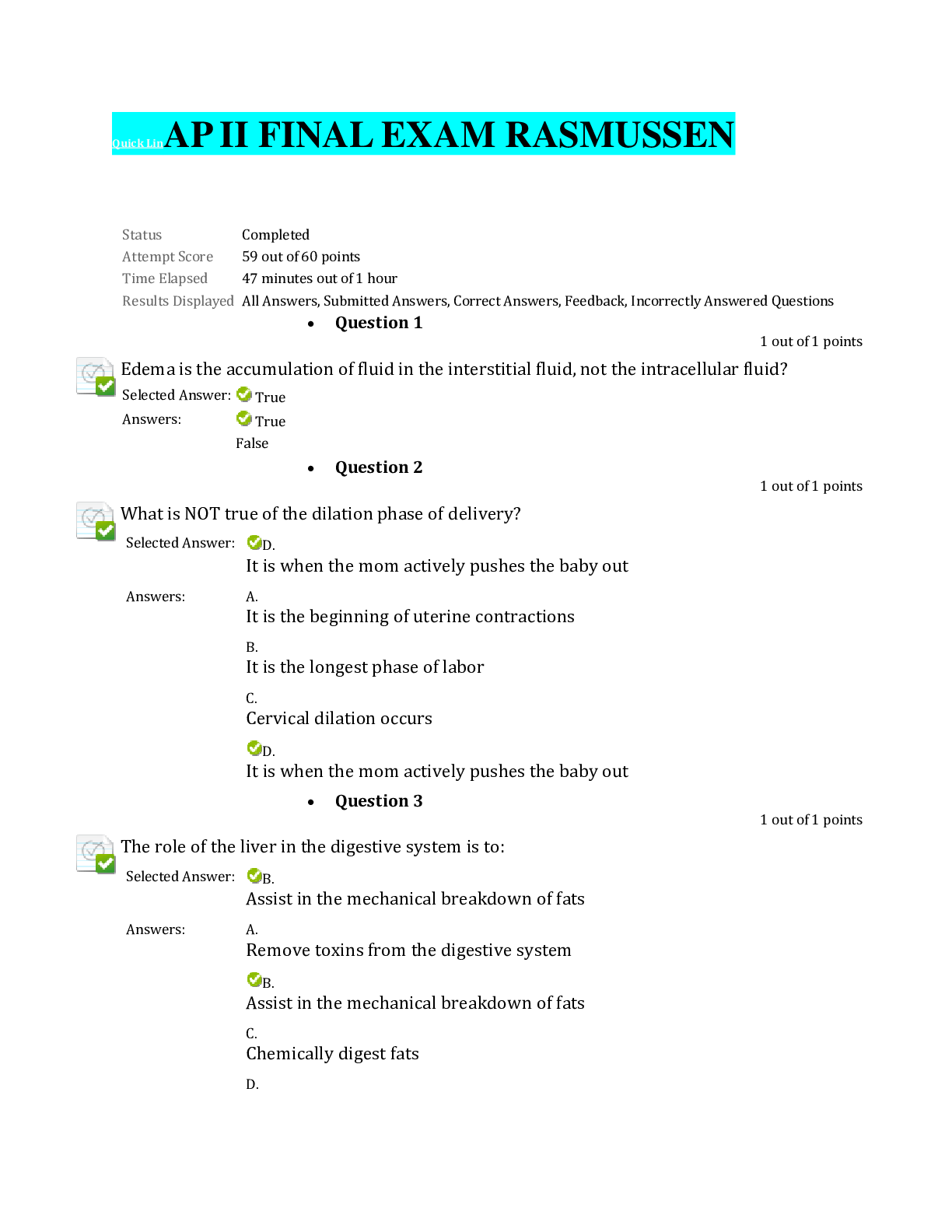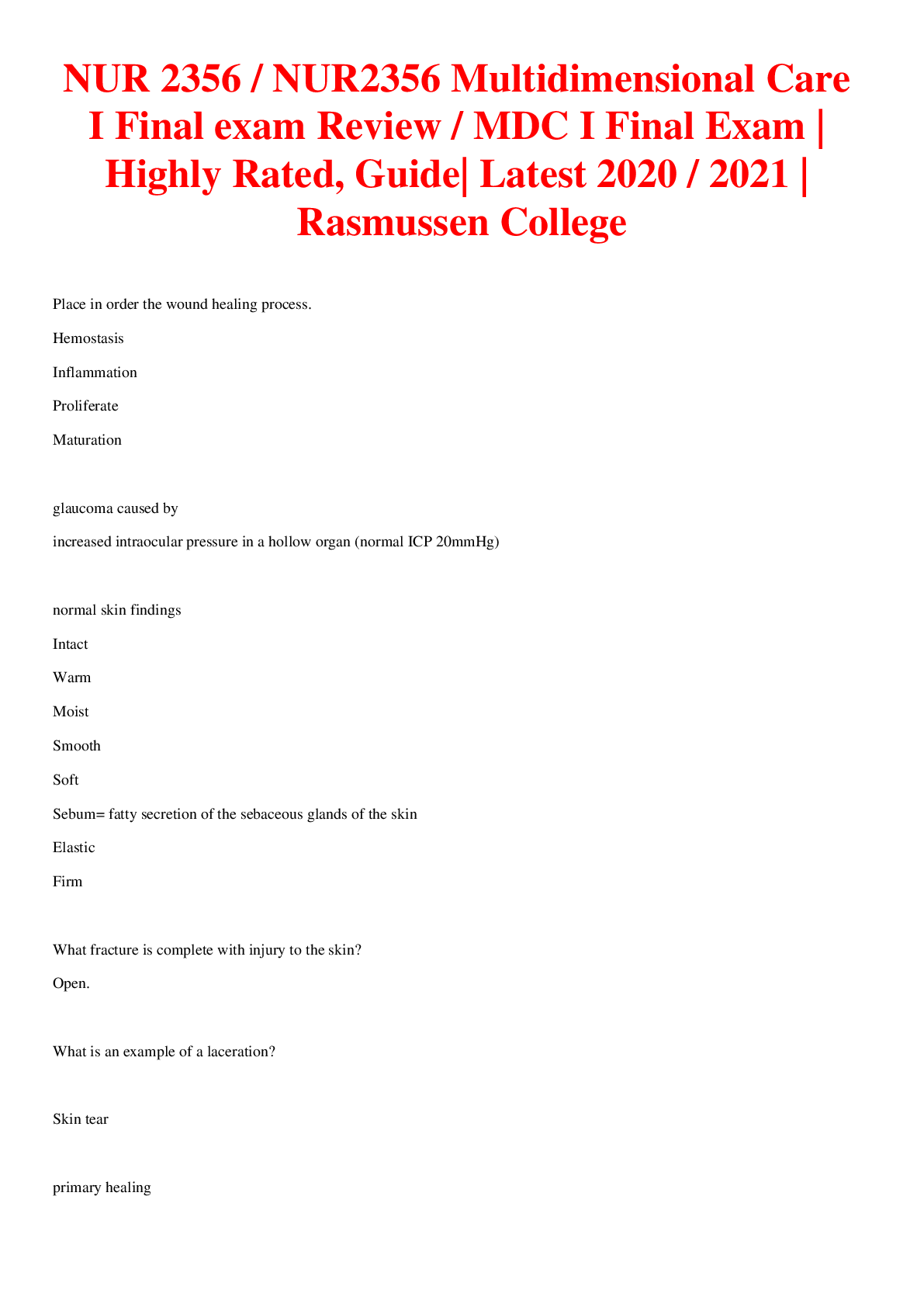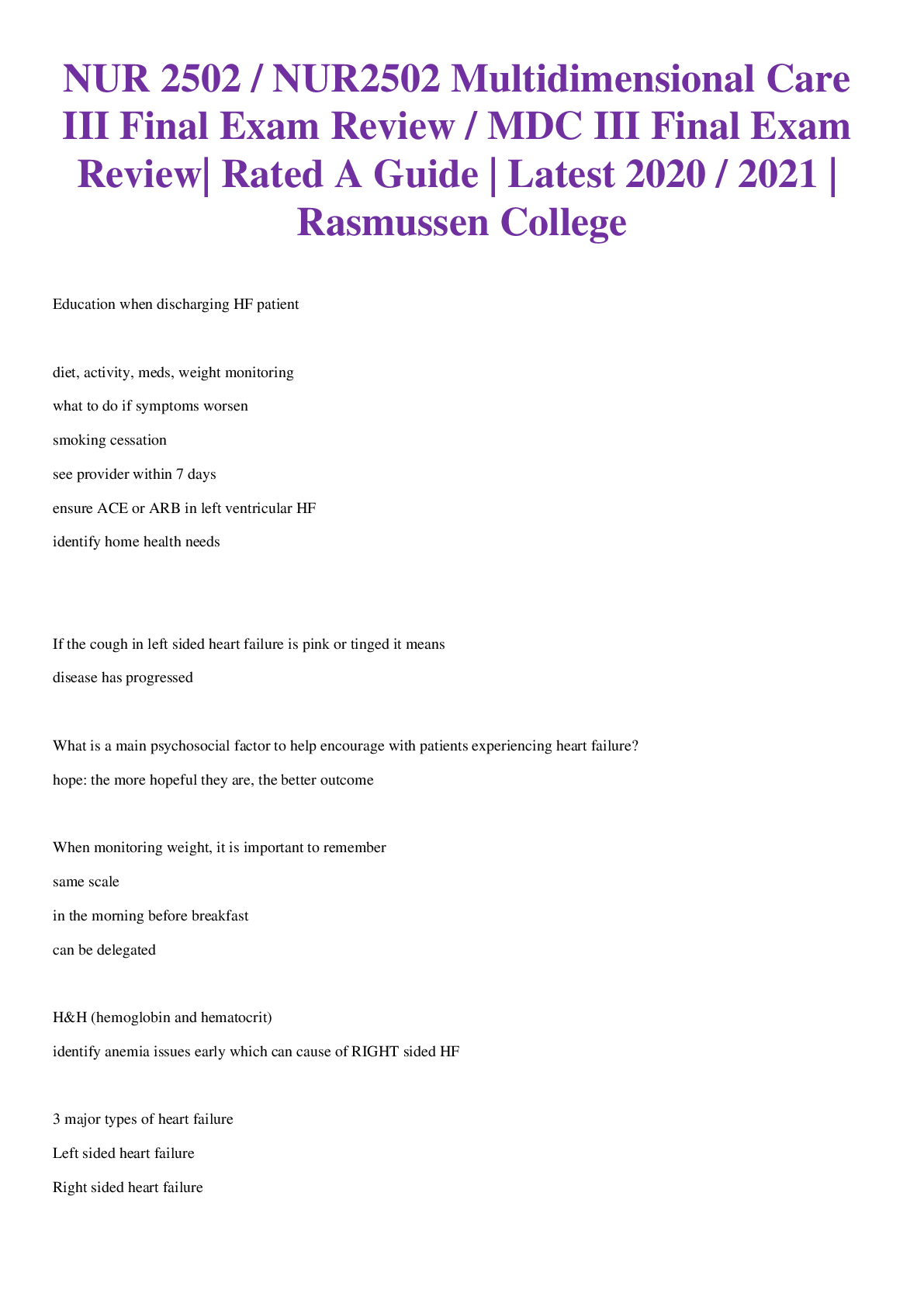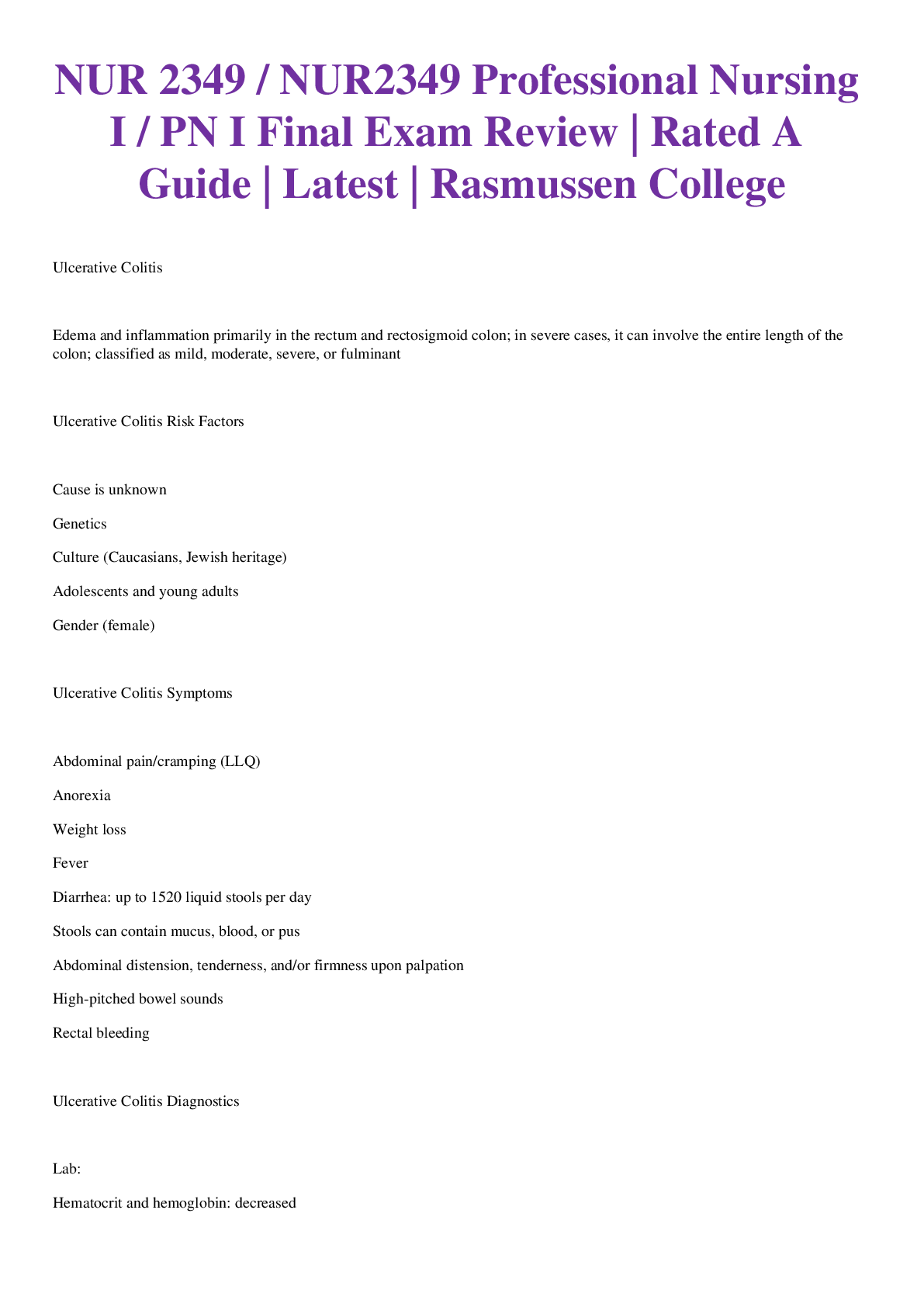Portage Learning BIOD 151 A&P I Final Exam Latest Update 2022
Document Content and Description Below
11/16/21, 7:50 PM Portage Learning A&P I Final Exam Flashcards | Quizlet https://quizlet.com/505864223/portage-learning-ap-i-final-exam-flash-cards/ 1/26 Free trial Portage Learning A&P I Final Exa... m Terms in this set (347) List two organs contained in the abdominal cavity. The abdominal cavity contains the stomach, intestines, spleen and liver True or False? a. Cellular respiration occurs in the mitochondria. (T or F) b. The purpose of cellular respiration is to produce ATP. (T or F) c. Integral proteins are only found on the inner surface of a cell membrane. (T or F) d. Endocytosis is the process that occurs to eject biomacromolecules from the cell. (T or F) e. Pinocytosis uses a signaling molecule from another cell, binding to the cell membrane to bring about changes within the cell proteins. (T or F) a. True b. True c. False d. False e. False Study sets, textbooks, questions Portage Learning A&P I Final Exam 11/16/21, 7:50 PM Portage Learning A&P I Final Exam Flashcards | Quizlet https://quizlet.com/505864223/portage-learning-ap-i-final-exam-flash-cards/ 2/26 You are observing two cells under the microscope. They are the same type of eukaryotic cell but one appears much larger. Based on appearance alone, which one would you expect to be carrying out respiration at a more active rate, the larger or smaller cell? Explain why. I believe it is the smaller cell that will breathe at a more active rate because in order for respiration to occur efficiently and more actively the surface area to volume ratio is very critical; also, if the larger surface area is present then the diffusion of gases occur at a higher rate; so, larger cells will have a smaller surface to volume ratio and diffusion that will occur at a slower rate creating a less active respiration; and, on the other hand smaller cells will have a larger surface area to volume ratio and an improved diffusion rate, so the higher rate and more active respiration. The smaller cell. Cells need to remain relatively small because as a cell expands the amount of surface area relative to the volume of the cell decreases. The smaller cell is more active because relative to its volume, its surface area is larger than a bigger cell. With a larger surface area (relative to its volume) this allows the metabolic processes to occur faster. Note: Essay answers must clearly be in your own words. Explain what happens to the epiglottis during swallowing. Why? During swallowing the epiglottis moves inferiorly to close off and prevent aspiration by covering the trachea and creating a passage for liquid, food, or bolus into the esophagus; and, preventing these things from entering into the lungs. Air and food pass in which one of the following areas: Oropharynx Label the following five items from the diagram: Label B- ___________ Label D- __________ Label E- __________ Label F- __________ Label G- __________ B - Oral Cavity D - Epiglottis E - Glottis F - Trachea G - Esophagus From widest to narrowest, the branches of the bronchial tree are: Primary bronchi, secondary bronchi, tertiary bronchi, bronchioles Portage Learning A&P I Final Exam 11/16/21, 7:50 PM Portage Learning A&P I Final Exam Flashcards | Quizlet https://quizlet.com/505864223/portage-learning-ap-i-final-exam-flash-cards/ 3/26 Explain why someone who has hypergastrinemia (excessive secretion of gastrin) might develop gastric/stomach ulcers. Hypergastrinemia leads to excess secretion of the gastrin hormone, which induces excess secretion of hydrochloric acid in the stomach; and, the excess acid then acts as a protective mucousa layer causing disruption that can lead to those ulcers. Gastrin stimulates the secretions of pepsinogens and hydrochloric acid. Excess amounts would lead to erosion of the stomach lining. Look carefully at the diagram below. Label the following 5 organs of the digestive system. To receive credit for the intestines you must label the specific region. 3: ___________ 4: ___________ 7: ___________ 9: ___________ 10: ___________ 3. Stomach 4. Gallbladder 7. Jejunum 9. Appendix 10. Rectum Note: Essay answers must clearly be in your own words. Answer the following essay question: Describe parietal cells and chief cells: name their location, secretions and purposes. Parietal and chief cells are located in the stomach wall and they secrete gastric juices and mucous, secrete hormones that regulate digestive activity; also, parietal cells produce HCl in the stomach; and, chief cells secrete te enzymes pepsinogen, rennin, and gastric lipase. The parietal cells (located in the wall of the stomach body) secrete hydrochloric acid, generating a pH of 1.3-3.5. This very acidic pH kills many of the bacteria ingested along with food. In addition, the low pH stops the activity of salivary amylase. The secretion of hydrochloric acid is essential in the activation of pepsin. Chief cells: secrete pepsinogen. Pepsinogen (a pre-enzyme) is secreted by the chief cells in the stomach. Hydrochloric acid converts the inactive pepsinogen (secreted by the chief cells) into the active enzyme pepsin which begins the breakdown of proteins. Portage Learning A&P I Final Exam 11/16/21, 7:50 PM Portage Learning A&P I Final Exam Flashcards | Quizlet https://quizlet.com/505864223/portage-learning-ap-i-final-exam-flash-cards/ 4/26 Upgrade to remove ads Only $35.99/year Label the following bones of the skeleton from the figure below: 1: ____________ 3:____________ 5:____________ 7: ____________ 8: ____________ 1: Frontal bone/frontal sinuses 3: Maxilla 5: Vomer 7: Maxilla 8: Mandible Label the bones in the figure below: A: ____________ B: ____________ C: ____________ D: ____________ E: _____________ A. Pisiform B. Hamate C. Capitate D. Trapezoid E. Trapezium A patient has a diagnosis of osteoporosis. (1) In your own words, describe this diagnosis and (2) What type of bone cell would they be lacking? Explain your answer. (1) The textbook states that osteoporosis is a bone tissue disease where the bone tissue degenerates faster than it is replaced making the bones weak, causing increased pain, and more likely to fracture due to them being brittle. (2) Furthermore, there would be a decreased number of osteoblasts, which are responsible for bone repair; also, the bone repair would be unable to keep up with the ongoing breakdown of the bone which is responsible in the process that included the osteoblasts that take the calcium from the blood. Portage Learning A&P I Final Exam 11/16/21, 7:50 PM Portage Learning A&P I Final Exam Flashcards | Quizlet https://quizlet.com/505864223/portage-learning-ap-i-final-exam-flash-cards/ 5/26 Label the following five muscles: B: _____________ C: _____________ E: _____________ G: _____________ J: ______________ B: Temporalis C: Orbicularis oculi E: Zygomaticus major G: Buccinator J: Depressor labii inferioris When extensor digitorum contracts, what action(s) occurs? A. Elbow extension B. Wrist extension C. Extension of digit 1 D. Extension of digits 2-5 E. A&C F. B&D F. B&D Would you expect a male to have estrogen in their bloodstream? Explain why or why not. Yes, the textbook stated that both the male and female bodies produce “all” the sex hormones; however, the ratios are different; also, the adrenal glands are largely responsible for producing this “opposite” hormone that the gonads of the person does not. List the hormone(s) that best describes the statement below: I promote the reabsorption of water at the collecting ducts of the kidneys. ADH List the hormone(s) that best describes the statement below: I am secreted by the beta cells of the pancreas. Insulin Portage Learning A&P I Final Exam 11/16/21, 7:50 PM Portage Learning A&P I Final Exam Flashcards | Quizlet https://quizlet.com/505864223/portage-learning-ap-i-final-exam-flash-cards/ 6/26 Upgrade to remove ads Only $35.99/year Explain in detail why the thyroid becomes enlarged during an iodine deficiency? When there is a low level of thyroxin in the blood, the anterior pituitary gland continues to produce TSH; so, the thyroid reacts by increasing in size and producing a goiter, but this increase in size is ineffective because active thyroxin cannot be produced without iodine. A- Identify the sensory cell receptor highlighted in blue, below, also indicated by the arrow. B- What sensory information is detected by this type of receptor? A) Pacinian corpuscle B) Detects pressure (mechanoreceptor) Match the cell with its single best description, using each description only once. Fibroblasts Produces collagen Keratinocytes Produces a protein to protect the skin Langerhans cells Assists in immune responses Melanocytes Produces a pigment that absorbs UV rays Fibroblasts Produces collagen Keratinocytes Produces a protein to protect the skin Langerhans cells Assists in immune responses Melanocytes Produces a pigment that absorbs UV rays Other Incorrect Match Options: Detects pain Detects light touch What is the name and function of the structure below? (Highlighted in blue, also indicated by the arrow) Sebaceous gland (oil gland) produces oil (sebum) to protect the skin and hair from drying. Portage Learning A&P I Final Exam 11/16/21, 7:50 PM Portage Learning A&P I Final Exam Flashcards | Quizlet https://quizlet.com/505864223/portage-learning-ap-i-final-exam-flash-cards/ 7/26 What is the study of the function of the human body? Physiology Epithelium is an example of what level of organization in the human body? Tissue What is the breakdown of nutrients? Catabolism List the four basic types of tissues. Epithelium, Muscle, Connective, and Nervous tissues. List the three layers of the skin in order from superficial to deep. The most superficial layer of the skin should be at the top of your list. To receive credit the layers must be in this order. Epidermis (Outer Layer), Dermis (Middle Layer), and Hypodermis (Subcutaneous and Inner Layer) Note: Essay answers must clearly be in your own words. Glucagon stimulates the breakdown of glycogen in the liver. Based upon your learning of metabolism, would this be considered an anabolic or catabolic hormone? Explain why. Catabolic hormone because it is breaking down of a larger substance, glycogen, into their simpler, smaller building blocks within the liver (releasing energy in the process). What anatomical orientation term is used to indicate "toward the back of the body"? Dorsal What anatomical orientation term is used to indicate "toward the upper part of a structure"? Superior What anatomical orientation term is used to indicate "toward the body surface"? Superficial (External) What anatomical orientation term is used to indicate "further from the origin of the body part"? Distal Portage Learning A&P I Final Exam 11/16/21, 7:50 PM Portage Learning A&P I Final Exam Flashcards | Quizlet https://quizlet.com/505864223/portage-learning-ap-i-final-exam-flash-cards/ 8/26 You are looking at a diagram of a patient standing in anatomical position. On the sheet of paper containing the diagram, which thumb points to the left side of the paper, right or left? Right Is the spine part of the axial or appendicular region of the body? Axial region A patient is standing in anatomical position. The patient moves his hand to scratch his nose. What anatomical action term is best used to indicate the motion occurring at his elbow? Flexion What anatomical action term is used to indicate "movement away from midline"? Abduction Describe the position of the diaphragm in relation to the thoracic cavity in anatomical position terms. Use a full sentence for your description. The diaphragm (muscle) assists in dividing the abdominopelvic region of the thoracic cavity by being superior to the organs (stomach, intestines, spleen, liver) of the abdominal cavity. Which anatomical action is occurring at the elbow joint, in the direction of the arrow? (Photo of arrow going down humerus pointing toward hand) Elbow Extension (Mod ule 1) Look at the figure below. The right femur is moved in the direction of the arrow. What anatomical action term best describes this movement? Adduction (Femur is moving towards the midline). Portage Learning A&P I Final Exam 11/16/21, 7:50 PM Portage Learning A&P I Final Exam Flashcards | Quizlet https://quizlet.com/505864223/portage-learning-ap-i-final-exam-flash-cards/ 9/26 True or False: The ventral body cavity contains the cranial cavity, the thoracic cavity, and the abdominal cavity. If your answer is false, rephrase the statement to make it a true statement. False The body is divided into anterior and posterior sections by what type of plane? Frontal (Coronal) A section that is diagonal between horizontal and vertical planes is called what? Oblique sections Look at the diagram below. What type of plane is shown? (Red plane cutting the body anteriorly/posterioly) Frontal (Coronal) Using the letters given, match the cell with the type of solution it has been placed in: A cell beginning to swell = Hypotonic A red blood cell placed in ocean water = Hypertonic A cell containing an equal amount of solute as the solution = Isotonic Using the letters given, match each molecule/item with its typical means of entering a cell. You may need to use some means of entry more than once. Lipid insoluble molecules = Facilitated diffusion Other cells = Endocytosis Water = Diffusion Which one of the following is not true of active transport? Active transport moves particles with the concentration gradient List the three organelles, in order, involved in the synthesis, transport and shipping of proteins. ribosomes, rough ER, Golgi complex Portage Learning A&P I Final Exam 11/16/21, 7:50 PM Portage Learning A&P I Final Exam Flashcards | Quizlet https://quizlet.com/505864223/portage-learning-ap-i-final-exam-flash-cards/ 10/26 Label the 5 organelles listed below: 3: ___________ 4: ___________ 5: ___________ 7: ___________ 8: ___________ 3: Nucleolus 4: Nuclear Envelope 5: Mitochondria 7: Lysosome 8: Endoplasmic Reticulum Note: Essay answers must clearly be in your own words. In your own words, discuss Tay-Sachs disease. What organelle within the cell is impacted? What are the symptoms of the disease and why do they occur? Tay-Sachs disease is a result from a lack of an enzyme that degrades another specific type of glycolipid; and, these glycolipids build up in the lysosomes (organelle within the cells that is impacted) of the brain, leading to progressive neural dysfunction and typically death by age 4 or 5 years; furthermore, other symptoms include seizures, muscle, weakness, vision and hearing loss, etc. 1. Lysosomes 2. Build up of toxic lipids inside the cell (biomacromolecules) 3. Disability or death Note: Essay answers must clearly be in your own words. You are observing two cells under the microscope. They are the same type of eukaryotic cell but one appears much larger. Based on appearance alone, which one would you expect to be carrying out respiration at a more active rate, the larger or smaller cell? Explain why. The smaller cell. Cell needs to remain relatively small because as a cell expands the amount of surface area relative to the volume of the cell decreases. The smaller cell is more active because relative to its volume, its surface area is larger than a bigger cell. With a larger surface area (relative to its volume) this allows metabolic processes to occur faster. How many lobes does the left human lung have? Left lung has 2 lobes in a human. Rings of cartilage line much of the respiratory tract. In which of one the following would cartilage NOT be found? Alveoli Portage Learning A&P I Final Exam 11/16/21, 7:50 PM Portage Learning A&P I Final Exam Flashcards | Quizlet https://quizlet.com/505864223/portage-learning-ap-i-final-exam-flash-cards/ 11/26 Label the following five items from the diagram: Label A- __________ Label C- __________ Label E- __________ Label F- __________ Label H- __________ A - Nasal Cavity C - Soft Palate E - Glottis F - Trachea H- Tongue Note: Essay answers must clearly be in your own words. Explain what happens to the soft palate during swallowing. Why? The soft palate elevates in an upward movement during swallowing to prevent food or liquid from entering the nasal passages. Note: Essay answers must clearly be in your own words. Explain at least two differences between Type I and Type II alveolar cells. Type I forms the very thin simple squamous epithelium of the alveoli within the junction of the capillaries; also, Type II produce and secrete pulmonary surfactant which is needed throughout the alveolar surface; and, Type II cells can divide to replace damaged Type I cells. True/False: Negative pressure is used to move air into the lungs. True True/False: During exhalation the diaphragm contracts to actively push air out of the lungs. False True/False: During inhalation the rib cage lifts in an upward motion to open and expand the lungs. True True/False: As the thoracic cavity expands and lung volume increases, the density of the gases filling the lungs decreases. True Portage Learning A&P I Final Exam 11/16/21, 7:50 PM Portage Learning A&P I Final Exam Flashcards | Quizlet https://quizlet.com/505864223/portage-learning-ap-i-final-exam-flash-cards/ 12/26 True/False: When the diaphragm rises, thoracic pressure increases and air naturally flows out of the lungs. True Boyle's law states that gas volume is: A. Directly proportional to temperature B. Inversely proportional to temperature C. Directly proportional to pressure D. Inversely proportional to pressure E. Both A and B D. Inversely proportional to pressure Typical respiratory epithelium contains all of the following, except which one? layers Which one of the following is not true of the pleurae? Visceral pleurae cover the diaphragm Which one of the following is not true of the bronchioles? Bronchioles can contain fossae and mucus Which one of the following is true of the respiratory physiology calculations? (You may find it helpful to draw the respiratory physiology diagram on a piece of scratch paper to help you answer this question.) Functional Residual Capacity (FRC) = RV+ERV True/False: Typical respiratory epithelium contains cells where only some of the pseudostratified columnar cells touch the basement membrane. False True/False: During inhalation, negative pressure draws air into the lungs. True Portage Learning A&P I Final Exam 11/16/21, 7:50 PM Portage Learning A&P I Final Exam Flashcards | Quizlet https://quizlet.com/505864223/portage-learning-ap-i-final-exam-flash-cards/ 13/26 True/False: The vestibule is lined with typical respiratory epithelium. False True/False: The fossae is another name for the pleural cavities. False True/False: Each red blood cell contains from 10- 100 molecules of hemoglobin. False Matching: -Smoking is often the cause of this disease. A. Emphysema -With this disease, mucus clogs the respiratory tract. B. Pleurisy -This condition results in fluid-filled alveoli. C. Pulmonary edema -This is inflammation of the pleurae. D. Cystic Fibrosis Smoking is often the cause of this disease. A. Emphysema With this disease, mucus clogs the respiratory tract. D. Cystic Fibrosis This condition results in fluid-filled alveoli. C. Pulmonary edema This is inflammation of the pleurae. B. Pleurisy The pressure of three gases equals 1 atmosphere. What is the partial pressure of oxygen (in mmHG) if nitrogen is 300 mmHg and carbon dioxide is 350 mmHg? To receive full credit you must show your work. X = 110 mmHg 1 atm = 760 mmHg 300 mmHg + 350 mmHg + X = 760 mmHg Why would warming air be beneficial to gas exchange? It would expand the air to make it more available for gas exchange; also, based on Charles's law. In gas exchange (external respiration): Oxygen diffuses from alveoli into capillaries, carbon dioxide diffuses from capillaries into alveoli The purpose of these cells are the primary immune defense of the alveoli: Alveolar macrophages Portage Learning A&P I Final Exam 11/16/21, 7:50 PM Portage Learning A&P I Final Exam Flashcards | Quizlet https://quizlet.com/505864223/portage-learning-ap-i-final-exam-flash-cards/ 14/26 Answer the following essay question (10 points): 1. Muscular dystrophy is a neuromuscular disease which restricts the lungs from fully expanding due to muscular weakness. If a person is diagnosed with muscular dystrophy: 1) Which of the following statements regarding pulmonary function would be true? 2) Explain your answer. A. Inspiratory capacity would be abnormally low B. Vital capacity would abnormally high C. Total lung capacity would remain the same 1. A. Inspiratory capacity would be abnormally low 2. Due to the muscular dystrophy muscles that would be responsible for inspiration would most likely be damaged; and, this accounts for progressive weakness and degeneration of skeletal muscles surrounding the lungs; so, the breathing process would be impaired because the muscles that help in expanding the lungs are at a weakened state; and, they would be unable to expand for inhalation; therefore, the "inspiratory capacity would be abnormally low" possibly leading to other issues. Which of the following statements is FALSE regarding the muscle pictured above depicted by the lab instructor? It protracts the scapula It stabilizes the scapula It works with the pectoralis minor to draw the scapula forward and laterally All of the above statements are true All of the above statements are false All of the above statements are true Identify the muscle in the picture above, specified by the lab instructor, and list its actions. Identified is the latissmus dorsi muscle and its actions are extension, adduction, and medial rotation at the shoulder. Portage Learning A&P I Final Exam 11/16/21, 7:50 PM Portage Learning A&P I Final Exam Flashcards | Quizlet https://quizlet.com/505864223/portage-learning-ap-i-final-exam-flash-cards/ 15/26 Which of the following statements is FALSE regarding the muscle pictured (highlighted in blue and specified by the arrow)? It is innervated by the lower scapular nerve It abducts the humerus It flexes the humerus It extends the humerus All of the above statements are true All of the above statements are false It is innervated by the lower scapular nerve (the deltoid is innervated by the axillary nerve.) Your patient has sustained a rotator cuff injury. It is determined that the axillary nerve was damaged as a result. Given this information, which of the muscles pictured above would you expect to be affected? b. Teres Minor: a. Internally rotates the humerus b. prevents upward slippage of the humerus during abduction c. innervated by the subscapular nerve d. prevents upward slippage of the humerus when the arm is at rest e. a. and b. f. c. and d. b. prevents upward slippage of the humerus during abduction Brachialis: (mark all that apply) Primary action is supination of the forearm Primary action is flexion of the elbow Innervated by the musculocutaneous nerve Innervated by the ulnar nerve Primary action is flexion of the elbow Innervated by the musculocutaneous nerve Portage Learning A&P I Final Exam 11/16/21, 7:50 PM Portage Learning A&P I Final Exam Flashcards | Quizlet https://quizlet.com/505864223/portage-learning-ap-i-final-exam-flash-cards/ 16/26 Triceps Brachii: (mark all that apply) Extends elbow Adducts humerus Innervated by radial nerve Innervated by axillary nerve Extends elbow Adducts humerus Innervated by radial nerve Flexor Carpi Radialis: (mark all that apply) Flexes the wrist Innervated by the radial nerve Ulnar deviation of the wrist Innervated by the median nerve Flexes the wrist Innervated by the median nerve Extensor Carpi Ulnaris: (mark all that apply) Extends the wrist Extends the fifth digit Innervated by the posterior interosseous nerve Located on the dorsal forearm Extends the wrist Innervated by the posterior interosseous nerve Located on the dorsal forearm Abductor Pollicis Longus: (mark all that apply) Located on the dorsal forearm Abducts the 1st digit Extends the wrist Innervated by the median nerve Located on the dorsal forearm Abducts the 1st digit List the 3 gluteal muscles in order from superficial to deep. Most superficial is the Gluteus Maximus, followed by the Gluteus Medius, and the deepest is the Gluteus Minimus. Tensor Fasciae Latea: (mark all that apply) Hip abduction lateral rotation of the tibia medial rotation of the tibia Attaches to the IT tract Innervated by the inferior gluteal nerve Hip abduction lateral rotation of the tibia Attaches to the IT tract Portage Learning A&P I Final Exam 11/16/21, 7:50 PM Portage Learning A&P I Final Exam Flashcards | Quizlet https://quizlet.com/505864223/portage-learning-ap-i-final-exam-flash-cards/ 17/26 Adductor Magnus: (mark all that apply) Hip adduction Hip medial rotation Innervated by the obturator nerve Innervated by the tibial nerve Hip adduction Hip medial rotation Innervated by the obturator nerve Innervated by the tibial nerve Which of the muscles pictured above acts to flex the hip joint? a Identify the muscle pictured above (highlighted in blue and specified by the arrow) and give its actions (to receive full credit, all actions must be listed.) Identified is the satorius muscle and its actions include flexion, lateral rotation, and abduction of the hip. Identify the muscle in the picture above, specified by the lab instructor, and list its innervation. Identified is the biceps femoris muscle and its innervation is the tibial nerve. Identify the muscle in the picture above, specified by the lab instructor, and its actions.(Dissection of the lower leg) Identified is the tibialis anterior muscle and its innervation is the deep peroneal nerve that acts as both an antagonist and a synergist for the tibialis posterior. Extensor Digitorum Longus: (mark all that apply) Extends toes Plantarflexes ankle Innervated by peroneal nerve Extends toes Innervated by peroneal nerve Soleus: (mark all that apply) Plantarflexes ankle Flexes the knee Innervated by tibial nerve Superficial muscle Deep muscle Plantarflexes ankle Innervated by tibial nerve Deep muscle Portage Learning A&P I Final Exam 11/16/21, 7:50 PM Portage Learning A&P I Final Exam Flashcards | Quizlet https://quizlet.com/505864223/portage-learning-ap-i-final-exam-flash-cards/ 18/26 Fill in the four blanks:Food enters the stomach from the ____A_______ via the ____B______ sphincter.Food exits the stomach via the ______C______ sphincter into the____D_______. A. esophagus B. cardiac sphincter (LES) C. pyloric sphincter D. small intestine Look carefully at the diagram below. Label the following 5 organs of the digestive system.To receive credit for the intestines you must label the specific region. 1: ___________ 2: ___________ 5: ___________ 6: ___________ 8: ___________ 1: Liver 2: Pancreas 5: Duodenum 6: Ileum 8: Ascending colon A doctor is looking to prescribe a larger dose of a vitamin that would not easily cause vitamin toxicity. What type of vitamin would be the best to prescribe? Explain your answer.A. Water soluble vitaminB. Fat soluble vitaminC. All of the above A. Water soluble vitamin; excess amounts of water soluble vitamin will not be stored in the body, so the body uses what it needs and secretes the remain; also, on the other hand, the body uses what it needs from the fat soluble vitamins and then stores it within the tissues and organs, and taking too many fat soluble vitamins regularly can cause vitamin toxicity along with other side effects. Explain which digestive system functions are carried out by the large intestine. Propels wastes from the body, reabsorbs water and electrolytes, and producing/absorbing of Vitamin K and certain B vitamins. Note: Essay answers must clearly be in your own words. Answer the following essay question: Name and explain the four main functions performed by the digestive system. The 4 main functions performed by the digestion system are ingestion (through the mouth), digestion (mechanical and chemical), absorption (food/nutrients for circulation), and defecation (excretion of waste products). Portage Learning A&P I Final Exam 11/16/21, 7:50 PM Portage Learning A&P I Final Exam Flashcards | Quizlet https://quizlet.com/505864223/portage-learning-ap-i-final-exam-flash-cards/ 19/26 Match the digestive organ with the one substance it produces: Large intestine Vitamin K Stomach Pepsinogen Small intestine Bile (Wrong) Large intestine Vitamin K Stomach Pepsinogen Small intestine Secretin Other Incorrect Match Options: Salivary amylase Trypsin Bile What is the purpose of the hormone Leptin? Decrease hunger, increase satiety Which of the following statements is false? The stomach is located along the right side of the abdomen below the diaphragm. True/False: Lipids can be divided into three categories: saturated fat, unsaturated fat, and cholesterol. True True/False: Catabolism combines smaller molecules to make larger molecules. False True/False: The oropharynx is the most superior region of the pharynx. False True/False: The pharynx has three types of skeletal muscle: circumferential, longitudinal and oblique. False True/False: The oblique layer of the stomach churning food into smaller pieces is an example of mechanical digestion. True Portage Learning A&P I Final Exam 11/16/21, 7:50 PM Portage Learning A&P I Final Exam Flashcards | Quizlet https://quizlet.com/505864223/portage-learning-ap-i-final-exam-flash-cards/ 20/26 Label the following three types of raised bumps on the tongue. Describe the purpose of type C. A: _____________________ B: _____________________ C: _____________________ Describe C: A: Filiform Papillae B: Circumvallate Papillae C: Fungiform Papillae Describe C: The papillae are raised bumps on the tongue. The three types of papillae help to grip food on the tongue: circumvallate, fungiform and filiform. Fungiform papillae contain taste buds. Which of the following statements is true concerning glycolysis? Glucose is broken down into two pyruvate molecules. Which of the following statements is true concerning the second stage of glucose breakdown? Two additional ATP are formed along with other electron carriers. Which of the following statements is false concerning the Electron Transport System? Anaerobic respiration is more efficient than aerobic respiration. Label the diagram below, including left or right. Describe tooth (A). A: Central Incisor C: Canine (cuspid) E: Mollar F: Maxilla (Hard Palate) Describe tooth type A: They are flat and thin, and their primary function is cutting food Match the structure with the best description: Uvula: Attached to the soft palate Portage Learning A&P I Final Exam 11/16/21, 7:50 PM Portage Learning A&P I Final Exam Flashcards | Quizlet https://quizlet.com/505864223/portage-learning-ap-i-final-exam-flash-cards/ 21/26 Match the structure with the best description: Small Intestine: Pancreas secretions enter here via Hepatopancreatic ampulla Match the structure with the best description: Submucosal (layer of tissue): Contains blood and lymph vessels Match the structure with the best description: Enamel: Located on the surface of the crown Match the structure with the best description: Common Bile Duct Contains secretions from the gallbladder Which of the following statements is TRUE concerning the function of bones? The carpals are an example of short bones. Which of the following statements is FALSE concerning bones? A foramen is a projection for a tendon or ligament attachment. Which of the following statements is FALSE about the skeletal system? A. The two main divisions of the skeletal system are: axial and appendicular. B. The two main divisions of the skeletal system are: vertebral and thoracic. C. The axial skeleton lies along the midline of the body. D. The vertebral division of the skeleton is included in the appendicular skeleton. E. B. and D. are false F. A. and C are false E. B. and D. are false Portage Learning A&P I Final Exam 11/16/21, 7:50 PM Portage Learning A&P I Final Exam Flashcards | Quizlet https://quizlet.com/505864223/portage-learning-ap-i-final-exam-flash-cards/ 22/26 The cranium is formed by _____ bones; the facial skeleton contains _____ bones. 8; 14 What bone is highlighted in blue in the figure below? (superior/internal view) Sphenoid bone Label the following vertebrae as: C= Lumbar Label the following vertebrae as: B= Thoracic What is the name of the foramina in the figure below? 1: _____________ 2: _____________ 3: _____________ 1: Carotid Canal 2: External Acoustic Meatus 3: Stylomastoid Foramen Label the following bone landmarks: B: ____________ D: ____________ E: _____________ H: _____________ I: ______________ B: Supraspinatus Fossa D: Acromion Process E: Neck H: Lateral Border I: Inferior Angle Portage Learning A&P I Final Exam 11/16/21, 7:50 PM Portage Learning A&P I Final Exam Flashcards | Quizlet https://quizlet.com/505864223/portage-learning-ap-i-final-exam-flash-cards/ 23/26 Which of the following statements is FALSE about the scapula? The clavicle connects to the coracoid process of the scapula. The clavicle connects to the scapula via the coracoid process. The lateral border of the scapula connects to the neck of the scapula. The supraspinatus fossa is located on the posterior side of the scapula. The clavicle articulates with the scapula. The clavicle connects to the coracoid process of the scapula. Which of the following statements is TRUE about the humerus? A. The lateral epicondyle of the humerus articulates with the ulna. B. The capitulum articulates with the ulna. C. The lateral epicondyle is the prominent bone landmark of the medial side of the elbow (in anatomical position). D. The head of the humerus articulates with the scapula. E. B. and D. are true D. The head of the humerus articulates with the scapula. The glenohumeral joint is prone to dislocation. In your own words, (1) Describe dislocation and (2) What happens in dislocation of the glenohumeral joint? 1. Dislocation of a joint means that the bone is removed from its socket. 2. Dislocation of the shoulder occurs when the head of the humerus is removed from the glenoid cavity in any direction. Label the bones in the figure below: A: ___________ C: ___________ D: ___________ F: ____________ G: ___________ A: Cuboid C: Intermediate Cuneiform D: Medial Cuneiform F: Navicular G: Calcaneus Red bone marrow: is found primarily in short and flat bones. Portage Learning A&P I Final Exam 11/16/21, 7:50 PM Portage Learning A&P I Final Exam Flashcards | Quizlet https://quizlet.com/505864223/portage-learning-ap-i-final-exam-flash-cards/ 24/26 The diaphysis of a bone: A. is found at the ends of long bones. B. contains the articular cartilage at joint articulations. C. contains the proximal epiphysis. D. is the center length of a bone. E. both A. and C. D. is the center length of a bone. Compact bone: A. forms the exterior of bones. B. forms the interior of bones. C. is lighter than spongy bone. D. contains numerous bars and plates with irregular spaces. E. both B. and D. A. forms the exterior of bones. Intramembranous ossification is the formation of _______ from ________: C. flat bones; connective tissue. What term best describes the type of fracture pictured below? Open (Compound) Fracture A patient has a diagnosis of osteoporosis. (1) In your own words, describe this diagnosis and (2) What type of bone cell would they be lacking? Explain your answer. 1. Osteoporosis is a bone tissue disease that occurs when bone tissue degenerates faster than it is replaced making the bones become weak; furthermore, brittle bones cause increased pain and are more likely to fracture. 2. They would have decreased osteoblasts which are responsible for bone repair; also, the bone repair would be unable to keep up with the ongoing breakdown of bone which is done by work of the osteoblasts. Your patient has back pain due to a herniated disc. (1) In your own words explain what it means to have a herniated disc. (2) As reviewed in the module, discuss one treatment option to address your patient's pain. 1. A herniated disc is an injury to the intervertebral disc, which is the center portion of the disc bulging into the vertebral foramen, causing pain. 2. Physical therapy for strengthening to support the back ligaments is a treatment option to address the bone. Portage Learning A&P I Final Exam 11/16/21, 7:50 PM Portage Learning A&P I Final Exam Flashcards | Quizlet https://quizlet.com/505864223/portage-learning-ap-i-final-exam-flash-cards/ 25/26 Matching: Match the joint with the correct joint classification (A-F). *NOTE: Some joints may fall into more than one category. Mark all that apply. A= Fibrous, B= Cartilaginous, C= Synovial, D= Hinge, E= Ball-andSocket, F=Saddle 1. Knee joint 2. Thumb joint 3. Shoulder joint 4. Vertebral joint 5. Cranial joints 1. Knee joint: C= Synovial, D= Hinge 2. Thumb joint: C= Synovial, F=Saddle 3. Shoulder joint: C= Synovial, E= Ball-and-Socket 4. Vertebral joint: B= Cartilaginous 5. Cranial joints: A= Fibrous Name the ligament highlighted in blue in the figure below: Anterior Sacroiliac Ligament (Mod 4) Name the ligament highlighted in blue in the figure below: PCL or posterior cruciate ligament Name the ligament highlighted in blue in the figure below: Coracohumeral Ligament There are five types of muscle tissue found in the body. False Smooth and cardiac muscle tissue are both under voluntary control. False The musculocutaneous nerve is part of the central nervous system. False Portage Learning A&P I Final Exam 11/16/21, 7:50 PM Portage Learning A&P I Final Exam Flashcards | Quizlet https://quizlet.com/505864223/portage-learning-ap-i-final-exam-flash-cards/ 26/26 A sensory signal is a signal that is sent from a muscle to the central nervous system. True The cervical plexus contains nerves that innervate the thigh. False Answer the following short-answer question: Tendons connect which types of tissue? Tendons connect muscle to bone. Answer the following short-answer question: Acetylcholine is what type of substance? Neurotransmitter Answer the following short-answer question: During a muscle contraction which protein myofilament is pulled along? Actin [Show More]
Last updated: 1 year ago
Preview 1 out of 26 pages
Instant download
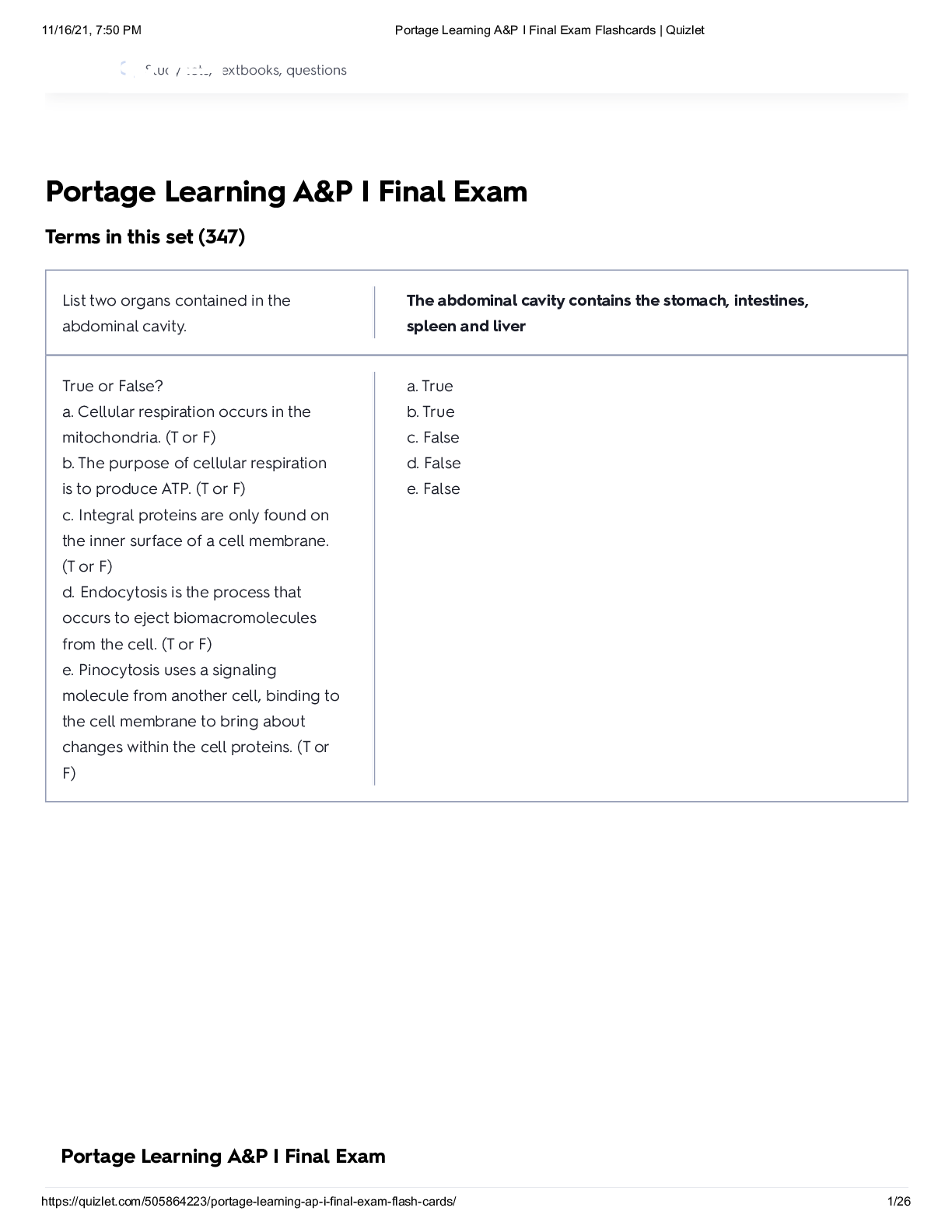
Buy this document to get the full access instantly
Instant Download Access after purchase
Add to cartInstant download
Reviews( 0 )
Document information
Connected school, study & course
About the document
Uploaded On
May 10, 2022
Number of pages
26
Written in
Additional information
This document has been written for:
Uploaded
May 10, 2022
Downloads
0
Views
36





.png)


